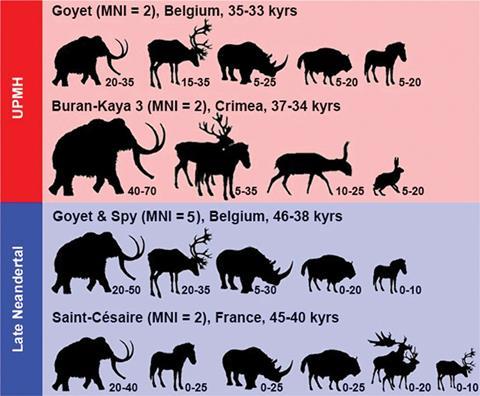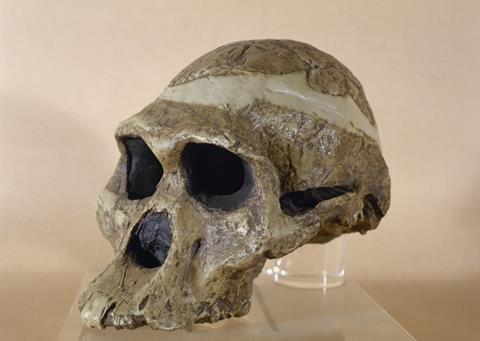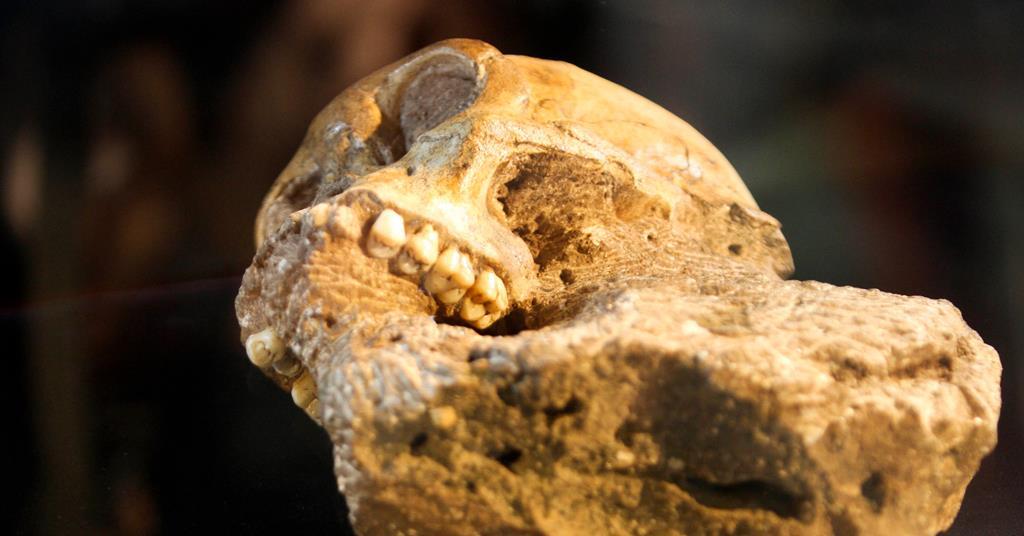-
Stable isotope analysis reveals ancient diets: By measuring ratios of carbon and nitrogen isotopes in bones and teeth, scientists can determine whether prehistoric individuals consumed C3 or C4 plants, and whether they were herbivores or carnivores. This technique has illuminated dietary habits from Neanderthals to early hominins.
-
Advanced methods refine dietary insights: Techniques like compound-specific isotope analysis (CSIA-AA) and novel nitrogen extraction from tooth enamel are helping researchers distinguish trophic levels and detect meat consumption, even in ancient and poorly preserved samples.
-
Neanderthal and early human diets diverged: While Neanderthals primarily consumed large herbivores, early modern humans showed more dietary flexibility, including fish consumption. High nitrogen isotope ratios in Neanderthals may reflect mammoth meat consumption or metabolic adaptations.
-
Tooth enamel expands the timeline: Innovations in calcium and nitrogen isotope analysis from enamel allow researchers to study weaning ages and dietary shifts in hominins millions of years ago, supporting theories like the ‘expensive tissue hypothesis’ linking diet quality to brain evolution.
This summary was generated by AI and checked by a human editor
It turns out the cliche ‘you are what you eat’, supposedly first said in 1826 by gastronome Jean Anthelme Brillat-Savarin, is truer than the Frenchman ever realised. Studying the stable isotope ratios measured from bone and teeth has become an important method for deciphering diet in archaeology and palaeontology. In particular, the ratios of carbon-13 to carbon-12 and nitrogen-15 to nitrogen-14 can illuminate what type of plants were part of a feeder’s food chain and whether they were a herbivore or carnivore.
The relationship between diet and the stable, non-radiogenic isotope ratios in animal tissue and bone was discovered in the late 1970s by geochemists Samuel Epstein and Michael DeNiro at the California Institute of Technology, US. Today, the field has widened to include other elements and developed new methods to eke out the often tiny samples available for analysis of our early ancestors or Neanderthal cousins. The results are giving new insights into the secrets of our species’ evolutionary success.
The isotope ratio you measure gives ‘the average of everything you’ve had for breakfast, lunch and dinner’, jokes archaeological scientist Michael Richards, from Simon Fraser University in British Columbia, Canada. The phenomenon is down to small differences in the kinetic behaviour of isotopes during metabolic processes. Handily for those studying diet, there are two plant categories with distinct isotopic ratios because of differences in the way they take up carbon dioxide during photosynthesis.
C3 plants, which include most species found in temperate regions such as rice, wheat, and potato, first convert carbon dioxide into a three-carbon 3-phosphoglyceric acid molecule. C4 plants, which include grasses and sedges such as millet or maize and are found in hotter tropical environments, first form a four-carbon oxaloacetate, which allows for a more efficient fixation reaction. While plants preferentially take up of the lighter carbon-12 isotope, the greater efficiency of the C4 pathway leads to less fractionation, so C4 plants will have a higher 13 C/12 C ratio. This has for example allowed archaeologists to follow the spread of millet cultivation through Europe in the late Bronze age (second millennium BCE), according to Richards.
Each time you eat some food, you get a higher ratio of nitrogen-15 to nitrogen-14 than the food you eat
These carbon isotope ratios are transferred from the plant to the tissue of whatever eats the plant and then up the food chain, which means it’s not possible to distinguish between a plant-eating herbivore or a carnivore who has eaten the herbivore. That’s where nitrogen isotope ratios become important. ‘It’s slightly different,’ says biogeologist Hervé Bocherens from the University of Tübingen in Germany. ‘Each time you eat some food, you get a higher ratio of nitrogen-15 to nitrogen-14 than the food you eat, there is an enrichment. So the higher you are in the food web, the higher your 15 N/14 N ratio.’ The enrichment occurs due to the faster breakdown and excretion of amino acids containing lighter nitrogen isotopes. ‘We can get a good grasp on the difference between a plant eater versus a meat eater versus a plant itself,’ says Jennifer Leichliter, a researcher at the Max-Planck Institute for Chemistry in Mainz, Germany. These differences are known as trophic levels.
The field has benefited greatly from advances in mass spectroscopy, and isotopic ratio mass spectroscopy (IRMS) is usually carried out with a multi-collector inductively coupled plasma mass spectrometer (MC-ICP-MS) which can measure multiple isotopes in the same run using an inductively coupled plasma to ionise the sample. The quantitative differences are at the sixth decimal says Vincent Balter, a geochemist and archaeological scientist at the Lyon Geology Laboratory in France. Standard samples are used between each run to ensure calibration.
Dietary requirements
Julia Lee Thorp, a leading figure in the field from the University of Oxford, UK, says there was a debate early on about what samples would give a reliable result and whether fossilised bone would be contaminated due to diagenesis – chemical changes occurring after a bone is deposited. The inorganic parts of bone seemed unreliable but remaining bone collagen is commonly sampled, which is combusted and the isotope ratios collected from the gases produced. In fresh bone, collagen makes up 25% by mass. ‘As long as we have about 10% of original collagen in the bone, we can extract it,’ says Bocherens. With current mass spectrometers he needs at least 0.3mg of collagen to get carbon and nitrogen isotopic values, which generally limits samples to 50,000 years ago.
Bocherens and others are probing the diets of early modern humans and Neanderthals in Europe up to that time, to identify distinctly human patterns that might explain our evolutionary success. Bocherens has sampled stable isotope ratios from both species from cave sites in Belgium around 45–43,000 years ago during the last ice age, but did not discover any large dietary differences – both groups seemingly consuming the same large herbivorous mammals.
But Richards says there is evidence that early humans were more versatile: for example, they ate fish by 30,000 years ago. Food originating from marine environments has a different carbon isotope ratio, ‘not because the plants in the ocean do anything different, it’s entirely that the base level [of carbon isotopes] is different,’ explains Richards. He thinks this may be evidence that modern humans were able to utilise a wider range of foods. ‘We spread out over the world, eating everything…to date, there’s almost no evidence of Neanderthal having fish.’
One surprising results found in several studies is a very high 15 N/14 N ratio for Neanderthals – the level typically found for the highest predators like lions or hyenas. It wasn’t clear what this meant about their diet – did this reflect the amount of meat they consumed, or could it be caused by something else, such as cooking their food or eating fish or even mushrooms? Concluding the trophic levels of omnivores using nitrogen isotope values for omnivores is not so straight forward. ‘We have data on bears, which are omnivores like people, that eat maybe 10–20% of meat, but they already have isotopic signature that looks like a carnivore, because most of their proteins come from the meat,’ says Bocherens.
To try and get round this problem Bocherens and others have started to look at the isotopic signatures of specific amino acids within their collagen samples in a method known as compound-specific isotope analysis (CSIA-AA). This allows them to calculate isotope ratios for two differently processed types of amino acids referred to as trophic and source. For trophic amino acids, nitrogen is readily recycled and re-used via the exchange of amino groups or their conversion to keto acids and ammonia, but source amino acids are likely to be incorporated directly into proteins. Because of the additional metabolic steps, trophic amino acids tend to be further enriched in nitrogen-15, so the difference between the two types will be larger as you climb the food chain.

‘It’s quite labour intensive, but it’s being used more and more,’ says Richards. Collagen samples extracted from bone are hydrolysed into their constituent amino acids which are then chemically modified to make them volatile so they can be separated by gas chromatography before isotope analysis. Richards used the method on Neanderthal collagen between 30,000 and 50,000 years old collected from two sites in France. He concluded that Neanderthal were indeed eating a largely carnivorous diet.
Bocherens conducted a similar study on Neanderthals from the cave sites in Belgium and came to a similar conclusion, estimating the Neanderthal diet included only 20% plants. The high ratio was likely due to their consumption of mammoth meat, which is also known to have an anomalously large nitrogen isotope ratio. One theory for this is that mammoths, although herbivores, metabolically evolved to survive food shortages through higher levels of amino acid recycling. This then leads to the high nitrogen isotope ratios measured, which match some carnivores.
The evidence we currently have for hominin diet rests on a very small number of samples. ‘If we count all the Neanderthals, we must have maybe 40 at the moment,’ says Bocherens. ‘The difficulty is to get a well-preserved collagen.’ He is starting to develop a compound-specific method to analyse less well-preserved bone that still contains small amounts of collagen. He will look for the amino acid hydroxyproline, a derivative of proline which makes up 10% of collagen amino acids and is only found in collagen. ‘If you have hydroxyproline, it’s genuinely the bone,’ he concludes.
Showing some teeth
The issue of preservation was also a hurdle for Lee Thorp in the 1980s when she started to look for ways to study the isotope ratios of much older hominins in South Africa. She broke new ground in proving that reliable results could be obtained from tooth enamel, extending the time-span of the method back from thousands to millions of years. Enamel is made from the calcium phosphate compound hydroxyapatite, but there is 3–5% of carbon present, says Lee Thorp: ‘enough to be able to determine the isotopic composition.’
Lee Thorp went on to study two hominin species: the short Australopithecus africanus, which lived between 3.3 and 2.1 million years ago, and Paranthropus robustus, a creature with enormous teeth, which existed 2.27 to 0.87 million years ago. Marks on their teeth suggested they ate fruits and nuts, but carbon isotope data gave a broader picture. ‘They were not concentrating alone on those things,’ says Lee Thorp; they also consumed C4 plants from the savanna grasslands, a departure from the sorts of diets you would expect for primates like chimpanzees and perhaps a sign of evolutionary shifts. She also detected the Australopithecus, generally considered to be more closely related to modern humans, had a more mixed diet of C3 and C4 plants.
Tooth enamel also contains calcium, and in the last five years Balter has been probing the ratio of stable calcium isotopes, something previously impossible. The ICP-MS technique uses a plasma of argon gas to ionise the sample and argon has an atomic mass of 40, which interferes with the mass range for calcium’s isotopes which range from 40 to 48. ‘There were huge interferences that prohibited measuring calcium isotopes because there was so much argon and so few calcium [atoms],’ explains Balter. But there are ways to get round this in the latest generation of ICP-MS. One method uses hydrogen in a reaction cell subsequent to the initial ionisation, which reacts with argon ions, causing them to become neutralised, ultimately preventing them reaching the detector.
Weaning age gives you information about the energy needs of a growing brain
Sampling calcium isotopes from teeth is allowing Balter to investigate the evolutionary important area of weaning age in early primates. The weaning age will be an indication of the duration between births and this could help reconstruct the likely size of primate communities as well as provide further evidence of evolutionary changes. ‘It gives you indirect information of the energy needs of the growing brain,’ says Balter. Isotope ratios that indicate more extensive breastfeeding could imply a more organised brain, needing more energy to develop.
In particular Balter is looking at enamel from the first molar teeth that form, which include a birth line and then growth in rings similar to that seen in trees. The calcium isotope ratio will change once an animal stops breastfeeding so measuring the ratios at different places on the in-built tooth timeline will provide a weaning age. Balter has so far measured the 44Ca/42Ca ratios in tooth enamel of 37 South African Australopithecus africanus, Paranthropus robustus and early human species and results suggest that early humans breastfed for longer and would therefore likely have had longer intervals between births.
A remaining difficulty is getting good nitrogen isotope data from hominin tooth enamel as its nitrogen content is less than 1% mass. This has led to Leichliter working with lab head Tina Lüdecke at the Max-Planck Institute for Chemistry to develop a novel method, in part borrowed from marine science where it has been used to study coral. ‘It’s kind of science fiction-y,’ jokes Leichliter, but it allows them to maximise the amount of nitrogen they can sample.
Their oxidative–denitrification method starts by dissolving a 5mg sample of tooth enamel to remove the mineral part. They oxidise the remaining organic fraction with a strong oxidising agent to convert any nitrogen present into nitrates, and this is then injected into a denitrifying bacteria, engineered to convert any nitrate into nitrous oxide (N2O). They use this gas to obtain the nitrogen isotope ratio without having to worry about contamination or background from atmospheric nitrogen. They take precautions like flushing their bacteria through with another gas before injecting their sample, to make sure there are no residue gases. ‘We also measure the bacteria itself to just monitor what their isotopic value is, if it’s changing, if it’s consistent,’ says Leichliter.
Rich food, expensive tissues?
Richards says there is some caution in the community, because of the risk of contamination from other sources of nitrogen. ‘We know in these old specimens there is contamination on fossilisation,’ he says. ‘We know they are not completely pristine.’ But Leichliter says their studies always test wider food webs to check the trophic levels indicated make sense. ‘Usually, once you have some sort of alteration your basic food web structure just disappears, the isotope values all look the same.’ This rarely happens. She thinks the small amount of protein in tooth enamel has been protected by the surrounding mineral layers, making them a rare case of the original protein surviving over millions of years.
Leichliter is hoping to use nitrogen isotope data to understand when early hominins started to consume meat. ‘We know that there were major changes in hominin diet that probably impacted our evolution,’ she says.

Earlier this year Ludecke and Leichliter published a study of carbon and nitrogen isotopes bound to tooth enamel in multiple species including seven Australopithecus fossils from a 3.5-million-year-old cave site at Sterkfontein in South Africa. ‘There have been a lot of discussions, especially recently, about whether or not these guys were actually incorporating some meat into their diet,’ but she says their study found them to be classic herbivores, in agreement with Lee Thorp’s results. ‘At least according to the nitrogen isotopes, these animals were predominantly eating plant material. It doesn’t mean that they couldn’t have included meat in their diet,’ she adds, ‘but it wasn’t so prevalent that it was showing up in the chemistry of their teeth.’
Leichliter is now studying the beginning of the Homo genus, to look for isotopic evidence of dietary changes. One theory, known as ‘the expensive tissue hypothesis’, suggests that the changes in brain structure that differentiate modern humans from their hominin ancestors were facilitated by higher quality food that provided the necessary energy to power something like the human brain. That change could be the introduction of more meat into their diet. Leichliter will sample some early Homo specimens to see if she can see any signs of meat eating at the very beginning of our lineage.
If mass spectrometry methods get better, we can go further back into the past
An alternative theory to meat-eating is that our early plant-eating ancestors found better ways to process their plant-based diets, such as grinding plants to break down their fibres so they could extract more energy. Cooking might be another way, but this can’t yet be identified isotopically. ‘This is something we are working on,’ says Leichliter. ‘There are isotopic effects that cooking can have on foods that we might be able to see.’ Compound-specific amino acid analysis might help here, or identifying higher levels of nitrogen-15 enrichment in meat cooked on a very hot fire.
Some researchers are now looking to other isotope ratios to build the widest possible picture. Oxygen isotopes have proved complex, but sulfur can be useful for differentiating food from coastal environments or those eating freshwater fish and can give information about the mobility of a population as the isotope ratio will change with location. Zinc isotope ratios are another way to detect trophic levels in the absence of surviving collagen, although results will also vary depending on local soil ratios. ‘We’ve scratched the surface so far, there’s a lot more to be done. I think that the advances in the future are going to come from combining some of these different [isotopic] approaches,’ says Lee Thorp.
These methods are of course all limited by the preservation of tissue and the sensitivity of mass spectrometry methods. ‘With [ancient] DNA you can amplify the tiniest amount, for us we need to burn the sample, so you need enough of it, but if the mass spectrometry methods get better and we can do smaller samples I think we can go back further into the past,’ says Richards.
Rachel Brazil is a science writer based in London, UK
